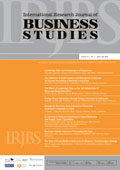Article Metrics |
|
|
Analysing K-Beauty Brands from the Consumer–Brand Relationship Perspective
Abstract
This study examines relationships between foreign brand halo effect and beauty consciousness on self-brand connection in beauty consumption. It also investigates the moderating role of age on these relationships. Data is gathered through an online survey focusing on two South Korean beauty (K-beauty) brands. The results contribute to consumer–brand relationships and international marketing literatures. There is no difference between young adult female and mature adult female consumers in the influence of beauty consciousness on self-brand connection. However, there are substantial differences between the two groups of consumers in the influence of the foreign brand halo effect on self-brand connection. Also, the halo effect exhibits the greatest influence on willingness to pay more. Consumers are also willing to pay more for brands from countries that have a positive image.
 https://doi.org/10.21632/irjbs.15.1.39-52
https://doi.org/10.21632/irjbs.15.1.39-52
Keywords
Full Text:
References
Assawavichairoj S. & Taghian M. (2017). Cross-cultural comparison of consumer pre-purchase decision-making: anti-aging products. Asia Pacific J Marketing Logistics, 29(1):27-46.
Ahmad, S. N. B. & Omar, A. (2018). Factors Driving female Consumers intention to purchase natural beauty products, International Journal of Accounting, Finance and Business, 3 (11), 72-81.
Ahmad, S.N.B, Omar, A.B. & Rose, R.B, (2015) Influence of Personal Values on Generation Z’s Purchase Intention for Natural Beauty Products, Advance in Global Business Research, 12 (1), 436-446
Alserhan, B.A., Halkias, D., Boulanouar, A.W., Dayan, M., & Alserhan, O.A. (2015). Expressing herself through brands: the Arab woman’s perspective, Journal of Research in Marketing and Entrepreneurship, 17 (1), 36 - 53
An, J., Do, D.K.X., Ngo, L.V. & Quan, T.H.M. (2019). Turning brand credibility into positive word-of-mouth: integrating the signaling and social identity perspectives, Journal of Brand Management, 26:157–175
Barak, B., & Stern, B. (1985). Fantastic at Forty! The New Young Woman Consumer, Journal of Consumer Marketing, 2 (2), 41-54
Clemes, M.D., Dean, D.L, & Thitiya, T. (2020). Modelling the behavioural intentions of day spa customers, Asia Pacific Journal of Marketing and Logistics, 1355-5855
DOI 10.1108/APJML-04-2019-0258
Chaplin, C. N. & John, D.R. (2005). The Development of Self-Brand Connections in Children and Adolescents, Journal of Consumer Research, 32, 119-129
Diamantopoulos, A., Davydova, O. & Arslanagic-Kalajdzic, M. (2018). Modelling the role of consumers xenocentrism in impacting preferenses for domestic and foreign brands: A mediation analysis, Journal of Business Research, https://doi.org/10.1016/j.jbusres.2018.12.007
El Jurdi, H. & Smith, S. (2018). Mirror, mirror: national identity and the pursuit of beauty, Journal of Consumer Marketing, 35 (1): 40-50.
Escalas, J. E. & Bettman, J.R. (2005), Self-Construal, Reference Groups and Brand Meaning, Journal of Consumer Research, 32(3): 378-389.
Fazli-Salehi, R., I. M. Torres, R. Madadi, & M. Á. Zúñiga. (2021). Is country affinity applicable for domestic brands? The role of nation sentiment on consumers’ self-brand connection with domestic vs foreign brands. Asia Pacific Journal of Marketing and Logistics 33 (3):731–54.
Fetscherin, M., Guzmán, F., Veloutsou, C., & Cayolla, R.R. (2019). Latest research on brand relationships: introduction to the special issue. Journal of Product & Brand Management, 28(2), 133-139.
Fornell, C.D. & Larcker, F. (1981). Evaluating structural equation models with unobservable variables and measurement errors. J. of Marketing Research 18, 39–50.
Fournier, S (1998). Consumers and Their Brands: Developing Relationship Theory in Consumer Research, Journal of Consumer Research. 24, 343-73
Ghazali, E., Soon, P.C, Mutum, D.S., & Nguyen, B. (2017). Health and cosmetics: Investigating consumers’ values for buying organic personal care products, Journal of Retailing and Consumer Services, 39, 154–163.
Gómez, M., Martín‐Consuegra, D., Díaz, E., & Molina, A. (2018). Determinants and outcomes of price premium and loyalty: A food case study, Journal Consumer Behavior. 17: 64–74.
Hair, J.F., Hult, G.T.M., Ringle, C.M., & Sarstedt, M. (2014). A Primer on Partial Least Squares Structural Equation Modeling (PLS-SEM). Sage, Thousand Oaks.
Han, C.M. (2020). Assessing the predictive validity of perceived globalness and country of origin of foreign brands in quality judgments among consumers in emerging markets, Journal of Consumer Behavior, 1-18, DOI., 10.1002/cb.1829.
Harmon-Kizer, T.R., Kumar, A., Orinau, D. & Stock, J. (2013). When multiple identities compete: The role of centrality in self-brand connections, Journal of Consumer Behavior, 12 (6): 483-495.
Hassani. H., Akhavan., M., Khakiyan, A., Shahghasemi, E., & Faghani, Z., Ostentation or Visibility: A Cultural Study of Consumption of Cosmetics by Iranian Young Women, Mediterranean Journal of Social Sciences, 6 (4): 182-189.
Haumann, T., Quaiser, B., Wieseke, J., & Rese, M. (2014). Footprints in the sands of time: A comparative analysis of the effectiveness of customer satisfaction and customer company identification over time. Journal of Marketing, 78(6): 78–102
Jung, J. (2018). Young Women’s Perceptions of Traditional and Contemporary Female Beauty Ideals in China, Family and Consumer Sciences Research Journal, 47 (1):56–72
Kadirov, D., Raju, C., Bardakci, A., Madak, N. & Khan, M.S. (2020). Does beauty have a price? The impact of a concepttualisastion of beauty on the price placebo effect in Turkey compared to New Zealand, Journal of Islamic Marketing, DOI. 10.1108/JIMA-0620190121
Kang, I., He, X. & Shin, M.M. (2020). Chinese consumers’ herd consumption behavior related to Korean luxury cosmetics: the mediating role of fear of missing out, Frontiers in Psychology, 11 (February), 1-11.
Kim, J., Han, W., Kim, D. & Paramita, W. (2013). Is beauty in the eye of the beholder? Gender and beauty in the cosmetics sector A comparative study of Indonesia and Korea, Marketing Intelligence & Planning, 31 (2), 127-140.
Koubaa, Y., Ulvoas, G., & Chew, P. (2011). The dual impact of traditional and national cultural
values on expatriate ethnic groups' attitudes and willingness to buy, Asia Pacific Journal of Marketing and Logistics, 23 (5),626 – 640.
Li, E.P.H., Min, H.J. & Lee, S., (2019). Soft power and nation rebranding The transformation of Korean national identity through cosmetic surgery tourism, International Marketing Review. 38, 141–162, DOI 10.1108/IMR-01-2019-0053.
Madan, S., Basu, S., Ng, S, & Lim, E. A.C. (2018). Impact of Culture on the Pursuit of Beauty: Evidence from Five Countries, Journal of International Marketing, 26(4) 54-68
Mandler.T., Won, S. & Kiom, K. (2017). Consumers' cognitive and affective responses to brand origin misclassifications: Does confidence in brand origin identification matter?, Journal of Business Research, 80, 197-209.
McCabe, M., de Waal Malefyt, T., & Fabri, A. (2017). Women, makeup, and authenticity: Negotiating embodiment and discourses of beauty. Journal of Consumer Culture. doi:10.1177/1469540517736558
Min, H., Park, J. & Kim, H.J. (2016). Common method bias in hospitality research: A critical review ofliterature and an empirical study. International Journal of Hospitality Management 56, 126–135.
Moliner, MA., Monferrer, D. & Estrada, M. (2018). Consequences of customer engagement and customer self-brand connection, Journal of Services Marketing, 32(4): 387-399.
Moliner-Velázquez, B., Ruiz-Molina, M.E. & Fayos-Gardó, T. (2015). Satisfaction with service recovery: moderating effect of age in word-of-mouth", Journal of Consumer Marketing, 32 (6). 470 - 484
Moslehpour, M. Wong,WK. Pham, K.V., & Aulia, CK. (2017) Repurchase intention of Korean beauty products among Taiwanese consumers, Asia Pacific Journal of Marketing and Logistics, 29 (3): 569-588.
Pathak, G. & Nichter, M. (2018), Cleanups, confidence, and cosmetics: marketing beauty in India, Journal of Consumer Culture, 0 (0): 1-21.
Pham, H. C.,& B. Richards. (2015). The western brands in the minds of Vietnamese consumers. Journal of Consumer Marketing, 32(5): 367-375.
Pileliene, L. & Šontaitė-Petkevičiencė, M. (2014) The effect of country of origin on beauty product choice in Lituania, Procedia – Social and Behavioural Sciences, 156, 458-462.
Pudaruth, S., Juwaheer, T.D., & Seewoo, Y.D. (2015) Gender-based differences in understanding the purchasing patterns of eco-friendly cosmetics and beauty care products in Mauritius: a study of female customers, Social Responsibility Journal, 11 (1). 179-198.
Qiu, Q., Wang, Y., Richard, J., & Wang, X., (2017). The impact of country of brand image on symbolic value of luxury brands, Asian Journal of Business Research, 7 (1), DOI:10.14707/ajbr.170033
Sarkar, A. S. Sreejesh, S., Sarkar, A & Dwivedi, Y.K. (2021). Impact of self‐brand connection on willingness to pay premium: Relevant mediators and moderators, Psychol Mark. 1–18. DOI: 10.1002/mar.21554
Sheth, J.N. (2017), Revitalizing relationship marketing, Journal of Services Marketing, 31 (1), 6-10.
Sihvonen, J. (2019). Understanding the drivers of consumer-brand identification, Journal of Brand Management, https://doi.org/10.1057/s41262-018-00149-z.
Sobh, R. (2011). Approaching what we hope for and avoiding what we fear: A study of women’s concern with visible signs of skin aging, Australasian Marketing Journal, 19, 122–130
Sulhaini, Rinuastuti, B.H. & Sakti, D.P.B. (2019. The halo effect of foreign brands on the misclassification of local brands, Management & Marketing: Challenges for the Knowledge Society, 14 (4): 357-371.
Sulhaini, Rusdan, Sulaimiah & Dayani, R. (2020). The effect of Local Brand Consciousness and Need for Uniqueness towards emotional value and buying intention on local brands, Majalah Bisnis, 19(1), doi.org/10.24123/jmb.v19i1
Steenkamp, J.E.M. (2019). Global Versus Local Consumer Culture: Theory, Measurement, and Future Research Directions, Journal of International Marketing, 1-19 DOI: 10.1177/1069031X18811289.
Tan, T.M., Salob, J., Juntunena, J., & Kumar, A. (2018). A comparative study of creation of self-brand connection amongst well liked, new, and unfavorable brands Journal of Business Research, 92, 71-80
Trepte, S. & Loy, L.S. (2017). Social identity theory and self categorization theory, The International Encyclopedia of Media Effects, edited by Patrick Rusller, John Wiley & Sons, Inc. DOI: 10/1002/978111878364.wbiemer0088
Wallström, Å. Steyn, P. & Pitt, L. (2010). Expressing herself through brands: A comparative study of women in six Asia-Pacific nations, journal of Brand Management 18 (3), 228–237
Xiao, Z., Zhang, J., Li, D., & Samutachak, B. (2016). The effect of e-WOM on country image and purchase intention: an empirical study on Korean cosmetic products in China Int. J. Services Technology and Management, 22 (1/2): 18-28.
Yang, J. (2011). Nennu and Shunu: Gender, Body Politics, and the Beauty Economy in China
Signs: Journal of Women in Culture and Society 36 (2): 333-357
Zakaria, N., Wan-Ismail, W.N, & Abdul-Talib, A.N. (2020). Seriously, conspicuous consumption? The impact of culture, materialism and religiosity on Malaysian Generation Y consumers’ purchasing of foreign brands, Asia Pacific Journal of Marketing and Logistics, 32(2):526-560.
Copyright (c) 2022 Sulhaini Sulhaini

This work is licensed under a Creative Commons Attribution-ShareAlike 4.0 International License.
International Research Journal of Business Studies has been covered by the following services: | ||||||||||||||||||||||||
|



















